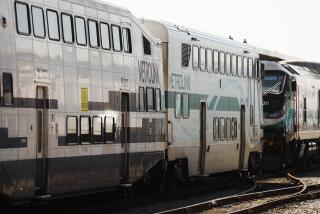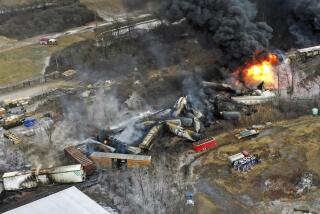Final report on deadly Metrolink crash comes down to signal color
As federal authorities prepare to close out a 16-month investigation of the deadly Chatsworth Metrolink disaster, a key issue remains in dispute: What color was the fateful final signal?
The only eyewitnesses to come forward publicly have maintained that the light was green as Metrolink 111 barreled toward a head-on crash with a Union Pacific freight train. And the conductor of the train told investigators that he radioed the Metrolink engineer before leaving Chatsworth station that the signal was green and the train was clear to proceed, records show.
But investigators with the National Transportation Safety Board insist all their testing and analysis of technical evidence strongly supports the opposite conclusion: The engineer, who was sending and receiving text messages while operating the train, sailed through a red light seconds before the accident that killed 25 and left 135 injured.
FOR THE RECORD:
An earlier version of this article included a caption that suggested a train signal had turned red because the Metrolink train shown was pulling out of the Chatsworth station. The train was southbound, approaching the Chatsworth station.
The signal conflict is fundamental to understanding the causes of the September 2008 catastrophe and could have significant implications in the wrongful death and injury lawsuits making their way through the courts.
Resolving the conflicting scenarios is likely to come up as the safety board meets Thursday to consider its final conclusions on the crash. “I think that’s a great question,” NTSB Chairwoman Deborah Hersman said in an interview last week when asked how the board would reconcile the differences.
Hersman declined to discuss details of the signal investigation in advance of the meeting in Washington. But a former NTSB member close to the investigation said the totality of evidence supports a finding that the signal was red.
Witness statements carry more weight “if it’s really a jump ball,” said Kitty Higgins, who led the agency’s investigative team at the scene and later headed an evidentiary hearing on the wreck. “In this case, I believe it’s really not.”
Signal history data, the position of the junction switch near the point of impact, extensive testing and cellphone text records all point to a conclusion that the Metrolink engineer who died in the crash, Robert M. Sanchez, was distracted and ran through a red signal, Higgins said.
“I don’t think [the witness accounts] rose to a level of undermining or casting doubt on all of the other information collected,” said Higgins, who left the NTSB last year.
In addition to the Metrolink conductor, a Chatsworth station security guard and two railroading enthusiasts who were regulars at the station told investigators they saw a green light that day. The conductor said he stepped out on the platform, looked at the light and radioed the engineer “highball on a green” -- meaning that the track was clear ahead.
The engineer apparently did not respond, but records show he sped away from the station as if he expected a green light.
Connex Railroad, a private contractor that employed and supervised both the engineer and the conductor, has suggested that the witness statements cast doubt on the status of the light. “They didn’t seem to pay much attention to the four eyewitnesses,” said Jim Hall, a former NTSB chairman and consultant to Connex.
The color of the light has implications in terms of liability to injured victims and survivors of those killed in the crash, said R. Edward Pfiester, one of the lead plaintiffs’ attorneys in legal proceedings over what are estimated to be hundreds of millions of dollars in claims.
If the engineer is held to be primarily at fault, Connex, a subsidiary of a French international conglomerate, would have greater exposure, he said.
If the signal malfunctioned and displayed a green, another large firm that contracts to maintain Metrolink’s signal equipment could be liable, he said.
But after a series of tests of the signals by plaintiffs’ experts, Pfiester said, “I very, very strongly believe the signal was not green. It was red.”
Federal investigators presented evidence about the crash at a public hearing in March. At Thursday’s meeting the board will determine a probable cause and contributing factors, as well as safety recommendations for Metrolink and other rail agencies. Board members have already been briefed on the proposed findings. But those can be debated and amended during Thursday’s meeting before the final written report is completed, Higgins noted.
The Chatsworth catastrophe already has prompted landmark federal legislation requiring railroads to enact sweeping safety measures and install a high-tech collision avoidance system on all U.S. trains.
Hersman said this week’s session would be a “watershed” opportunity for the NTSB to underscore the need to follow through despite concerns about the proposed braking system’s high costs.
“One of the tragedies of this discussion is that we had to lose 25 additional lives on the Metrolink” to get the law enacted, Hersman said.
More to Read
Sign up for Essential California
The most important California stories and recommendations in your inbox every morning.
You may occasionally receive promotional content from the Los Angeles Times.










